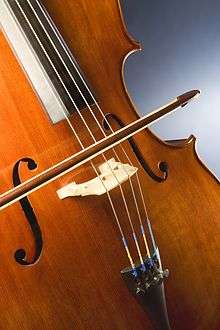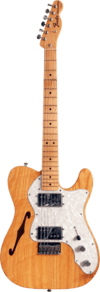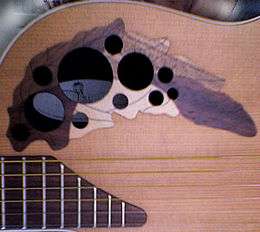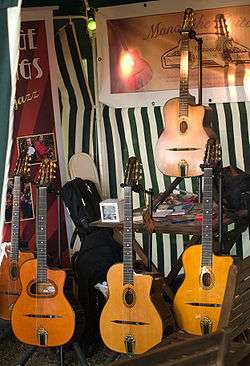Sound hole
A sound hole is an opening in the upper sound board of a stringed musical instrument. The sound holes can have different shapes: round in flat-top guitars and traditional bowl-back mandolins; F-holes in instruments from the violin family, archtop mandolins and in archtop guitars; C-holes in violas da gamba, and rosettes in lutes. Bowed lyras have D-holes and mandolins may have F-holes, round or oval holes. A round or oval hole is usually a single one, under the strings. F-holes and D-holes are usually made in pairs placed symmetrically on both sides of the strings. Most hollowbody and semi-hollow electric guitars also have F-holes.
Though the purpose of sound holes is to help acoustic instruments project their sound more efficiently, the sound does not emanate solely (nor even mostly) from the location of the sound hole. The majority of sound emanates from the surface area of both sounding boards, with sound holes playing a part by allowing the sounding boards to vibrate more freely, and by allowing some of the vibrations which have been set in motion inside the instrument to travel outside the instrument.
In 2015 researchers at MIT published an analysis charting the evolution and improvements in effectiveness of violin F-hole design over time.[1][2]
Alternative sound hole designs
Some Ovation stringed instruments feature a particularly unique soundhole architecture with multiple smaller soundholes that, being combined with a composite arch-top guitar body are said to produce a clear and bright sound.
Tacoma Guitars has developed a unique "paisley" soundhole placed on the left side of the upper bout of their "Wing Series" guitars. This is a relatively low-stress area that requires less bracing to support the hole.[3]
A few hollowbody or semi-hollow electric guitars, such as the Fender Telecaster Thinline and the Gibson ES-120T, have one f-hole instead of two, usually on the bass side.
Holes not positioned on the top of an acoustic guitar are called soundports.They are usually supplementary to a main soundhole, and located on an instrument's side facing upward in playing position, allowing players to monitor their own sound.[4]
Gallery

 F-holes on a Gibson L-5 archtop guitar.
F-holes on a Gibson L-5 archtop guitar. Single F-Hole on a Fender Telecaster Thinline guitar.
Single F-Hole on a Fender Telecaster Thinline guitar. Leaf sound hole in an Ovation Adamas guitar.
Leaf sound hole in an Ovation Adamas guitar.- Many acoustic guitars incorporate rosette patterns around the sound hole.
 Maccaferri guitars have D or Oval shaped sound holes.
Maccaferri guitars have D or Oval shaped sound holes. Unique Sound Hole with Kanji symbol by Cc Guitar
Unique Sound Hole with Kanji symbol by Cc Guitar C-holes on a viol.
C-holes on a viol.
References
External links
- Stringworks U - brief explanation of the effects of sound holes, with a closeup diagram of an F-shaped soundhole
